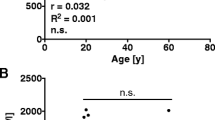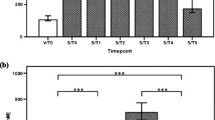Abstract
Growth arrest-specific 6 (Gas6) is widely expressed in leukocytes, platelets, endothelial cells, and monocytes. It regulates various processes including granulocyte adhesion to the endothelium, cell migration, thrombus stabilization, and cytokine release. In humans, increased plasma Gas6 levels have been described in patients with sepsis and septic shock. In this study, Gas6 concentrations were measured in postmortem serum from femoral blood in a series of sepsis-related fatalities and control cases. The aims were twofold: first, to determine whether Gas6 can be reliably determined in postmortem serum; and second, to assess its diagnostic potential in identifying sepsis-related deaths. Two study groups were prospectively formed, a sepsis-related fatalities group (24 cases) and a control group (24 cases) including cases of deep vein thrombosis and fatal pulmonary embolism, cases of systemic inflammatory response syndrome in severe trauma, cases of end-stage renal failure, and cases of hanging (non-septic, non-SIRS, non-end stage renal failure cases). The preliminary results of this study seem to indicate that Gas6 can be effectively measured in postmortem serum. However, Gas6 levels in sepsis-related fatalities do not appear to be clearly distinguishable from concentrations in pulmonary embolism, severe trauma, and end-stage renal failure cases. These findings tend to support previous reports that indicated that Gas6 behaves as an acute phase reactant and can be considered a general marker of inflammation rather than a specific biomarker of sepsis.
Similar content being viewed by others
References
Uehara S, Handa H, Gotoh K, Tomita H, Sennshuu M (2009) Plasma concentrations of growth arrest-specific protein 6 and protein S in patients with acute pancreatitis. J Gastroenterol Hepatol 24:1567–73
Lee IJ, Hilliard B, Swami A, Madara JC, Rao S, Patel T, Gaughan JP, Lee J, Gadegbeku CA, Choi ET, Cohen PL (2012) Growth arrest-specific gene 6 (Gas6) levels are elevated in patients with chronic renal failure. Nephrol Dial Transplant 27:4166–72
Alciato F, Sainaghi PP, Sola D, Castello L, Avanzi GC (2010) TNF-alpha, IL-6, and IL-1 expression is inhibited by GAS6 in monocytes/macrophages. J Leukoc Biol 87:869–75
Fiebeler A, Park JK, Muller DN, Lindschau C, Mengel M, Merkel S, Banas B, Luft FC, Haller H (2004) Growth arrest specific protein 6/Axl signaling in human inflammatory renal diseases. Am J Kidney Dis 43:286–95
Hung YJ, Lee CH, Chu NF, Shieh YS (2010) Plasma protein growth arrest-specific 6 levels are associated with altered glucose tolerance, inflammation, and endothelial dysfunction. Diabetes Care 33:1840–4
Park JK, Theuer S, Kirsch T, Lindschau C, Klinge U, Heuser A, Plehm R, Todiras M, Carmeliet P, Haller H, Luft FC, Muller DN, Fiebeler A (2009) Growth arrest specific protein 6 participates in DOCA-induced target-organ damage. Hypertension 54:359–64
Gibot S, Massin F, Cravoisy A, Dupays R, Barraud D, Nace L, Bollaert PE (2007) Growth arrest-specific protein 6 plasma concentrations during septic shock. Crit Care 11:R8
Tjwa M, Bellido-Martin L, Lin Y, Lutgens E, Plaisance S, Bono F, Delesque-Touchard N, Hervé C, Moura R, Billiau AD, Aparicio C, Levi M, Daemen M, Dewerchin M, Lupu F, Arnout J, Herbert JM, Waer M, García de Frutos P, Dahlbäck B, Carmeliet P, Hoylaerts MF, Moons L (2008) Gas6 promotes inflammation by enhancing interactions between endothelial cells, platelets, and leukocytes. Blood 111:4096–105
Que YA, Delodder F, Guessous I, Graf R, Bain M, Calandra T, Liaudet L, Eggimann P (2012) Pancreatic stone protein as an early biomarker predicting mortality in a prospective cohort of patients with sepsis requiring ICU management. Crit Care 16:R114
Llewelyn MJ, Berger M, Gregory M, Ramaiah R, Taylor AL, Curdt I, Lajaunias F, Graf R, Blincko SJ, Drage S, Cohen J (2013) Sepsis biomarkers in unselected patients on admission to intensive or high-dependency care. Crit Care 17:R60
Palmiere C, Augsburger M (2014) Endocan measurement for the postmortem diagnosis of sepsis. Leg Med (Tokyo) 16:1–7
American College of Chest Physicians/Society of Critical Care Medicine Consensus Conference (1992) Definition for sepsis and organ failure and guidelines for the use of innovative therapies in sepsis. Crit Care Med 20:864–74
Palmiere C, Bardy D, Mangin P, Augsburger M (2013) Value of sTREM-1, procalcitonin and CRP as laboratory parameters for postmortem diagnosis of sepsis. J Infect 67:545–55
Augsburger M, Iglesias K, Bardy D, Mangin P, Palmiere C (2013) Diagnostic value of lipopolysaccharide-binding protein and procalcitonin for sepsis diagnosis in forensic pathology. Int J Legal Med 127:427–35
Schrag B, Roux-Lombard P, Schneiter D, Vaucher P, Mangin P, Palmiere C (2012) Evaluation of C-reactive protein, procalcitonin, tumor necrosis factor alpha, interleukin-6, and interleukin-8 as diagnostic parameters in sepsis-related fatalities. Int J Legal Med 126:505–12
Borgel D, Clauser S, Bornstain C, Bièche I, Bissery A, Remones V, Fagon JY, Aiach M, Diehl JL (2006) Elevated growth-arrest-specific protein 6 plasma levels in patients with severe sepsis. Crit Care Med 34:219–22
Ekman C, Linder A, Akesson P, Dahlbäck B (2010) Plasma concentrations of Gas6 (growth arrest specific protein 6) and its soluble tyrosine kinase receptor sAxl in sepsis and systemic inflammatory response syndromes. Crit Care 14:R158
Blostein MD, Rajotte I, Rao DP, Holcroft CA, Kahn SR (2011) Elevated plasma gas6 levels are associated with venous thromboembolic disease. J Thromb Thrombolysis 32:272–8
Laurance S, Lemarié CA, Blostein MD (2012) Growth arrest-specific gene 6 (gas6) and vascular hemostasis. Adv Nutr 3:196–203
Robins RS, Lemarié CA, Laurance S, Aghourian MN, Wu J, Blostein MD (2013) Vascular Gas6 contributes to thrombogenesis and promotes tissue factor up-regulation after vessel injury in mice. Blood 121:692–9
van der Meer JH, van der Poll T, Van 't Veer C (2014) TAM receptors, Gas6, and protein S: roles in inflammation and hemostasis. Blood 123:2460–9
Hurtado B, de Frutos PG (2010) GAS6 in systemic inflammatory diseases: with and without infection. Crit Care 14:1003
Rothlin CV, Ghosh S, Zuniga EI, Oldstone MB, Lemke G (2007) TAM receptors are pleiotropic inhibitors of the innate immune response. Cell 131:1124–36
Palmiere C, Mussap M, Bardy D, Cibecchini F, Mangin P (2013) Diagnostic value of soluble CD14 subtype (sCD14-ST) presepsin for the postmortem diagnosis of sepsis-related fatalities. Int J Legal Med 127:799–808
Palmiere C, Augsburger M, Mangin P (2014) High-mobility group box-1 protein determination in postmortem samples. Forensic Sci Int 239:103–6
Conflict of interest
The authors declare that they have no competing interests.
Funding source
This study was not financially supported.
Author information
Authors and Affiliations
Corresponding author
Rights and permissions
About this article
Cite this article
Palmiere, C., Augsburger, M. Postmortem serum protein growth arrest-specific 6 levels in sepsis-related deaths. Int J Legal Med 129, 1079–1084 (2015). https://doi.org/10.1007/s00414-015-1230-2
Received:
Accepted:
Published:
Issue Date:
DOI: https://doi.org/10.1007/s00414-015-1230-2




